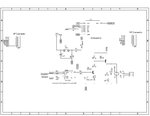RohanDey
Member level 2
Hello,
I have a cascaded D flip flop circuit. Schematic attached. I am sending the data and clock pulse from a PIC microcontroller.
What happens is, when the data and clock pulses are sent the leds glow properly as expected. But after a minute or two, the flip flop states get changed automatically and the leds also glows accordingly.
I am not sending any data-clock pulse after the first one. But still the flip flops gets changed.
Please help!
I have a cascaded D flip flop circuit. Schematic attached. I am sending the data and clock pulse from a PIC microcontroller.
What happens is, when the data and clock pulses are sent the leds glow properly as expected. But after a minute or two, the flip flop states get changed automatically and the leds also glows accordingly.
I am not sending any data-clock pulse after the first one. But still the flip flops gets changed.
Please help!







